docker怎么搭建maven私有仓库以及使用
这篇文章主要介绍“docker怎么搭建maven私有仓库以及使用”,在日常操作中,相信很多人在docker怎么搭建maven私有仓库以及使用问题上存在疑惑,小编查阅了各式资料,整理出简单好用的操作方法,希望对大家解答”docker怎么搭建maven私有仓库以及使用”的疑惑有所帮助!接下来,请跟着小编一起来学习吧!
创新互联建站10多年企业网站设计服务;为您提供网站建设,网站制作,网页设计及高端网站定制服务,企业网站设计及推广,对楼梯护栏等多个方面拥有丰富的网站推广经验的网站建设公司。
maven私有仓库一般是企业为你建立项目管理而构建的来存储maven项目开发中的依赖jar文件和jar文件的管理,提高工作效率。下面就使用Doker来搭建maven私有仓库并使用,步骤如下:
使用docker安装Nexus
通过Docker search nexus 命令,搜索nexus镜像,先择合适的镜像,如:docker.io/sonatype/nexus3
如图所示:

拉取Nexus镜像,执行命令:docker pull docker.io/sonatype/nexus3 ,如下图所示:

创建仓库,并给仓库文件夹权限,命令如下:
mkdir -p /usr/local/nexus3/nexus-data chown -R 200 /usr/local/nexus3/nexus-data
Nexus创建容器,并启动,命令如下:
docker run -tid -p 8081:8081 --name nexus -e NEXUS_CONTEXT=nexus -v /usr/local/nexus3/nexus-data:/nexus-data -d docker.io/sonatype/nexus3
通过docker ps 查看Nexus是否启动成功(注:若正常启动,则代表Nexus安装成功)
注:docker 的使用和常用命令,后续会文章中会有详细讲解。
Nexus的配置
登录nexus(注:访问:http://ip:8081/nexus 使用默认管理员身份登录,帐号:admin,密码:admin123)如下图所示:

进入管理界面,如下图所示:
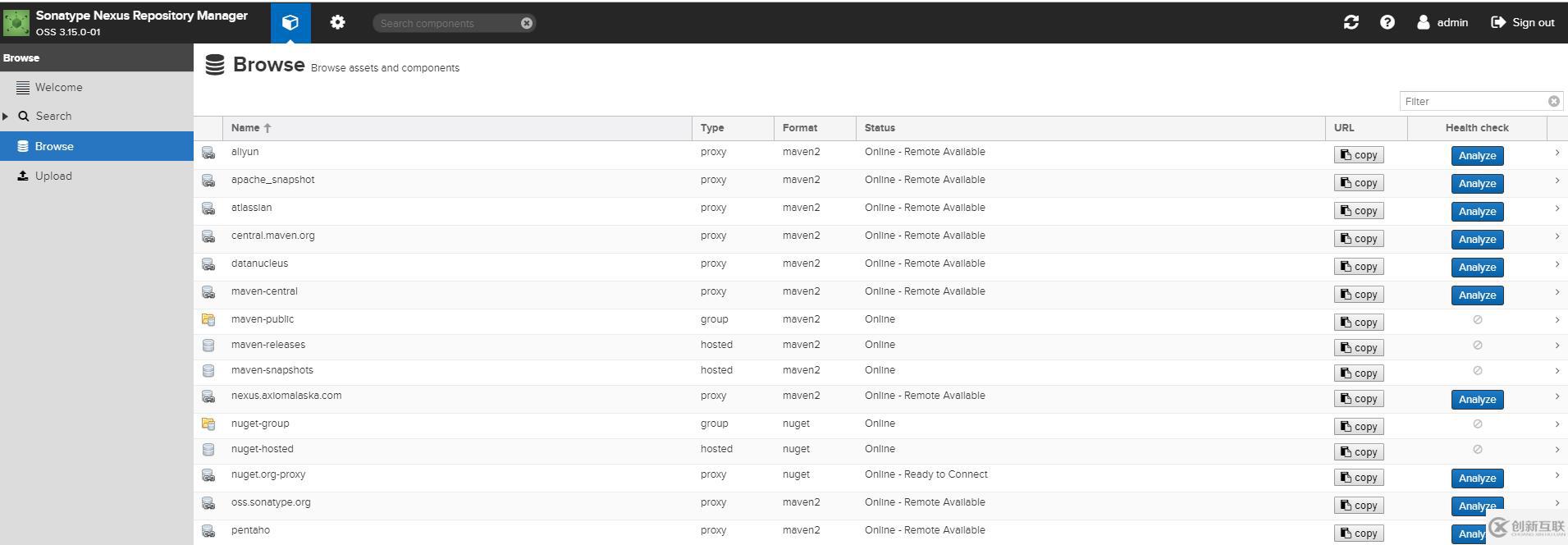
Browse可以查看当前有多少仓库,搭建好的Nexus,默认会带有一些maven仓库,一般使用这些仓库就足够了。
i. 默认仓库说明:
maven-central:maven中央库,默认从https://repo1.maven.org/maven2/拉取jar maven-releases:私库发行版jar,初次安装请将Deployment policy设置为Allow redeploy maven-snapshots:私库快照(调试版本)jar maven-public:仓库分组,把上面三个仓库组合在一起对外提供服务,在本地maven基础配置settings.xml或项目pom.xml中使用
ii. 仓库类型
Group:这是一个仓库聚合的概念,用户仓库地址选择Group的地址,即可访问Group中配置的,用于方便开发人员自己设定的仓库。maven-public就是一个Group类型的仓库,内部设置了多个仓库,访问顺序取决于配置顺序,3.x默认Releases,Snapshots, Central,当然你也可以自己设置。 Hosted:私有仓库,内部项目的发布仓库,专门用来存储我们自己生成的jar文件 3rd party:未发布到公网的第三方jar (3.x去除了) Snapshots:本地项目的快照仓库 Releases: 本地项目发布的正式版本 Proxy:代理类型,从远程中央仓库中寻找数据的仓库(可以点击对应的仓库的Configuration页签下Remote Storage属性的值即被代理的远程仓库的路径),如可配置阿里云maven仓库 Central:中央仓库 Apache Snapshots:Apache专用快照仓库(3.x去除了)
新增代理源,操作如下:
(1). 按照步骤添加新的代理源
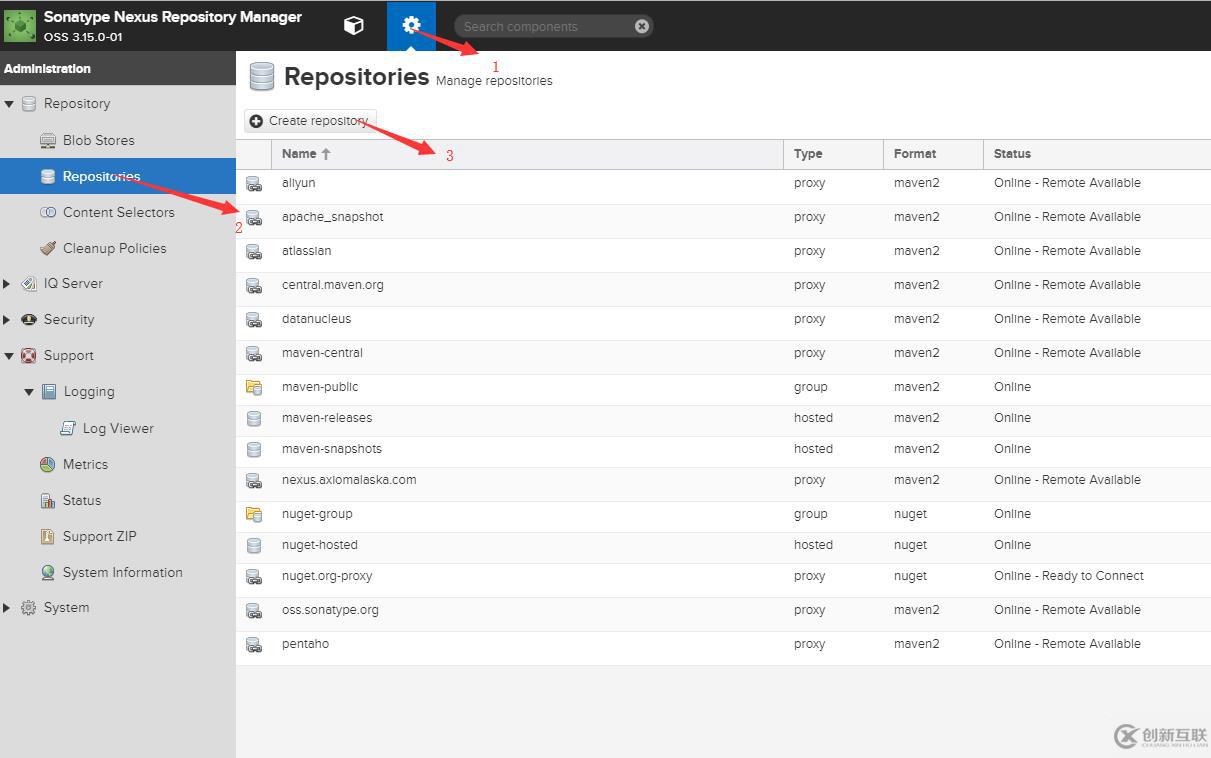
(2). 选择添加的代理,如maven2
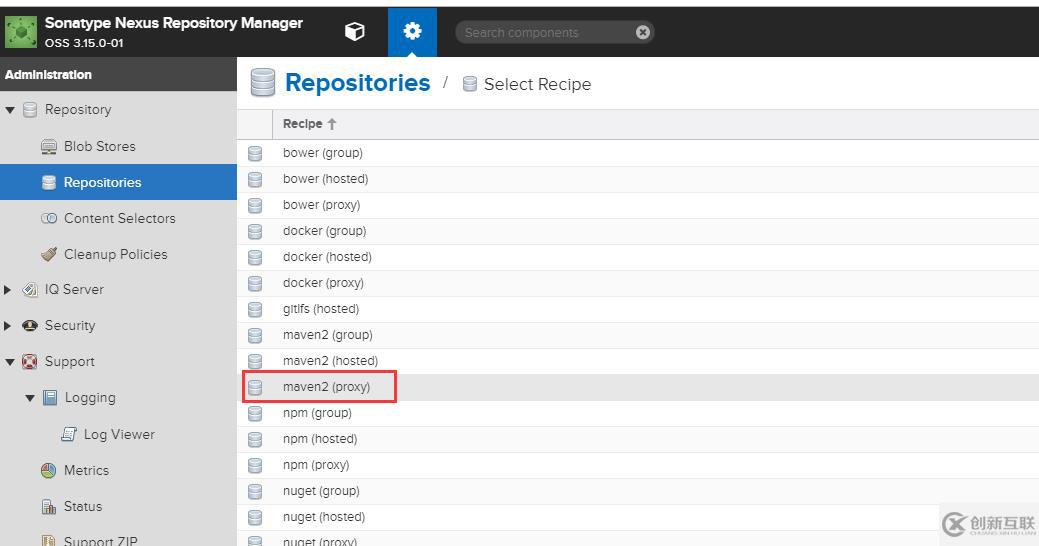
(3). 添加代理(Cache统一设置为200天 288000)
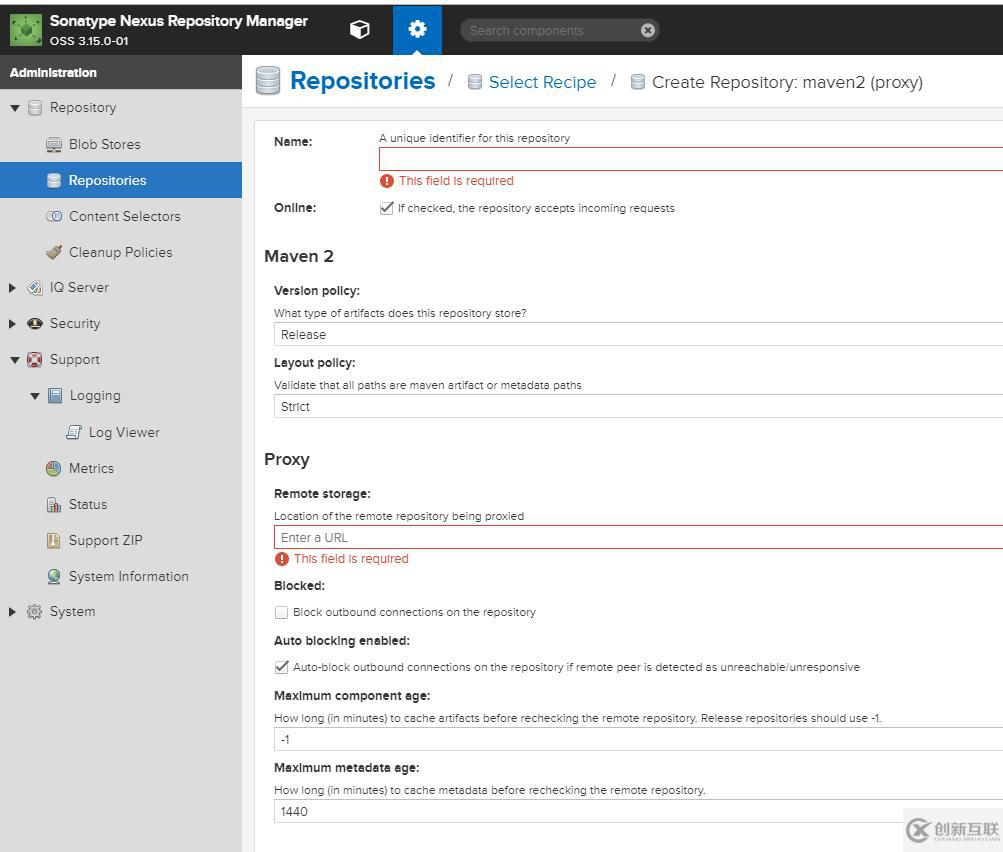
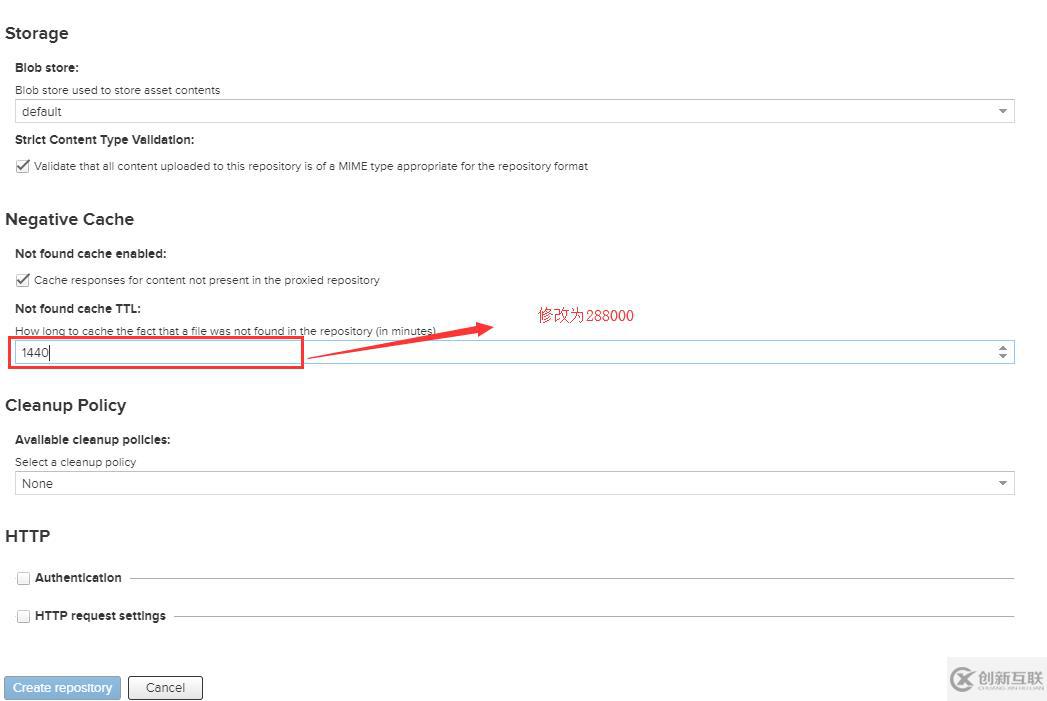
(4). 逐个增加常用代理
1. aliyun http://maven.aliyun.com/nexus/content/groups/public 2. apache_snapshot https://repository.apache.org/content/repositories/snapshots/ 3. apache_release https://repository.apache.org/content/repositories/releases/ 4. atlassian https://maven.atlassian.com/content/repositories/atlassian-public/ 5. central.maven.org http://central.maven.org/maven2/ 6. datanucleus http://www.datanucleus.org/downloads/maven2 7. maven-central (安装后自带,仅需设置Cache有效期即可) https://repo1.maven.org/maven2/ 8. nexus.axiomalaska.com http://nexus.axiomalaska.com/nexus/content/repositories/public 9. oss.sonatype.org https://oss.sonatype.org/content/repositories/snapshots 10.pentaho https://public.nexus.pentaho.org/content/groups/omni/
(5). 设置maven-public 将这些代理加入Group,最好将默认的maven库放到最底下
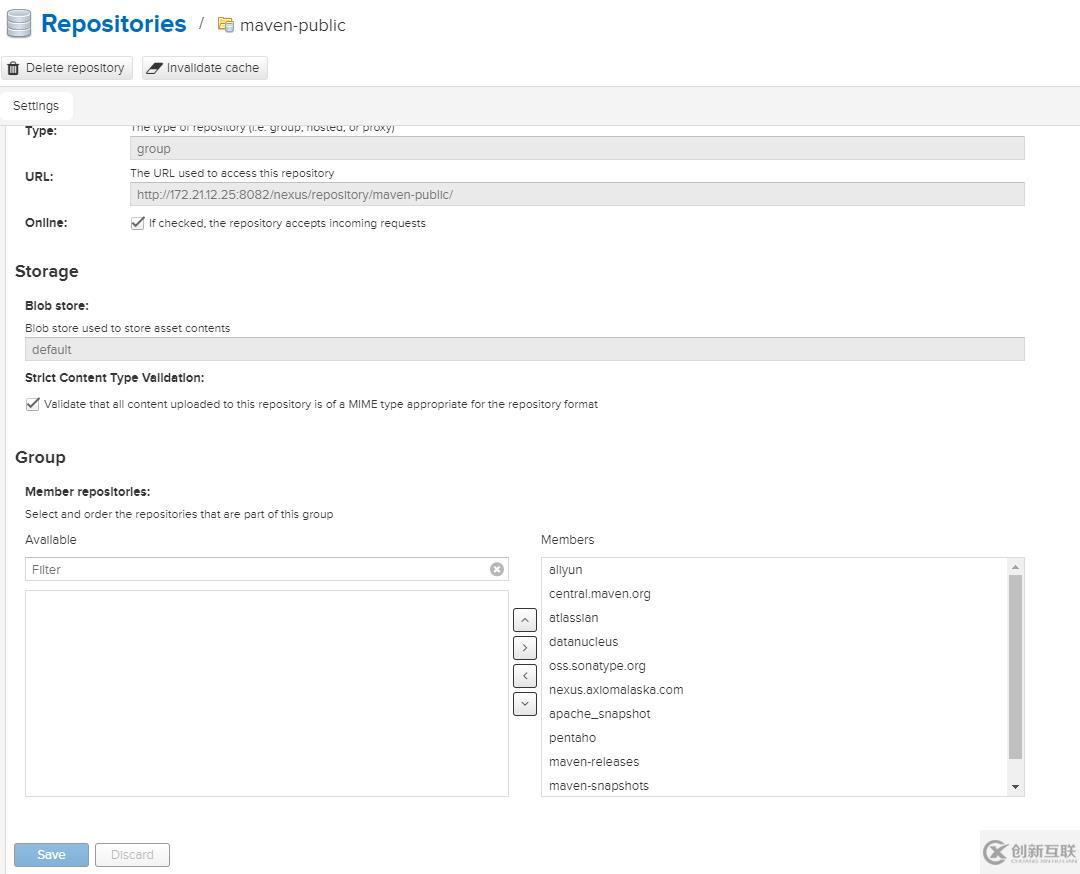
(6).设置私用仓库可重复发布(注:Nexus安装后自带maven-releases,maven-snapshots两个仓库,用于将生成的jar包发布在这两个仓库中,在实际开发中需要将maven-releases设置为可以重复发布)
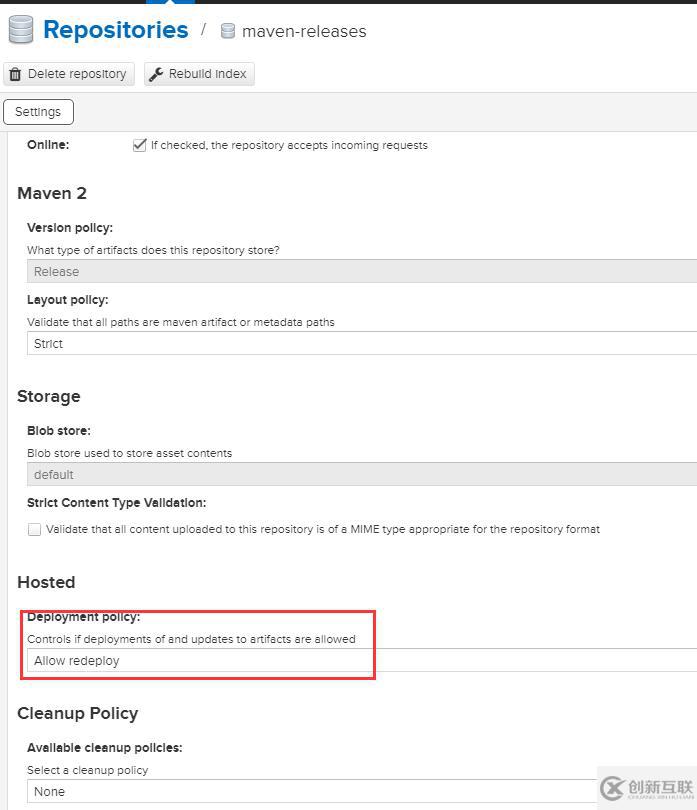
配置maven,使用Nexus
修改本机下的.m2下面的setting.xml文件配置,图下:
<?xml version="1.0" encoding="UTF-8"?>
<!--
Licensed to the Apache Software Foundation (ASF) under one
or more contributor license agreements. See the NOTICE file
distributed with this work for additional information
regarding copyright ownership. The ASF licenses this file
to you under the Apache License, Version 2.0 (the
"License"); you may not use this file except in compliance
with the License. You may obtain a copy of the License at
http://www.apache.org/licenses/LICENSE-2.0
Unless required by applicable law or agreed to in writing,
software distributed under the License is distributed on an
"AS IS" BASIS, WITHOUT WARRANTIES OR CONDITIONS OF ANY
KIND, either express or implied. See the License for the
specific language governing permissions and limitations
under the License.
-->
<!--
| This is the configuration file for Maven. It can be specified at two levels:
|
| 1. User Level. This settings.xml file provides configuration for a single user,
| and is normally provided in ${user.home}/.m2/settings.xml.
|
| NOTE: This location can be overridden with the CLI option:
|
| -s /path/to/user/settings.xml
|
| 2. Global Level. This settings.xml file provides configuration for all Maven
| users on a machine (assuming they're all using the same Maven
| installation). It's normally provided in
| ${maven.conf}/settings.xml.
|
| NOTE: This location can be overridden with the CLI option:
|
| -gs /path/to/global/settings.xml
|
| The sections in this sample file are intended to give you a running start at
| getting the most out of your Maven installation. Where appropriate, the default
| values (values used when the setting is not specified) are provided.
|
|-->
<settings xmlns="http://maven.apache.org/SETTINGS/1.0.0"
xmlns:xsi="http://www.w3.org/2001/XMLSchema-instance"
xsi:schemaLocation="http://maven.apache.org/SETTINGS/1.0.0 http://maven.apache.org/xsd/settings-1.0.0.xsd">
<!-- localRepository
| The path to the local repository maven will use to store artifacts.
|
| Default: ${user.home}/.m2/repository
-->
<localRepository>${user.home}/.m2/repository</localRepository>
<!-- interactiveMode
| This will determine whether maven prompts you when it needs input. If set to false,
| maven will use a sensible default value, perhaps based on some other setting, for
| the parameter in question.
|
| Default: true
<interactiveMode>true</interactiveMode>
-->
<!-- offline
| Determines whether maven should attempt to connect to the network when executing a build.
| This will have an effect on artifact downloads, artifact deployment, and others.
|
| Default: false
<offline>false</offline>
-->
<!-- pluginGroups
| This is a list of additional group identifiers that will be searched when resolving plugins by their prefix, i.e.
| when invoking a command line like "mvn prefix:goal". Maven will automatically add the group identifiers
| "org.apache.maven.plugins" and "org.codehaus.mojo" if these are not already contained in the list.
|-->
<pluginGroups>
<!-- pluginGroup
| Specifies a further group identifier to use for plugin lookup.
<pluginGroup>com.your.plugins</pluginGroup>
-->
</pluginGroups>
<!-- proxies
| This is a list of proxies which can be used on this machine to connect to the network.
| Unless otherwise specified (by system property or command-line switch), the first proxy
| specification in this list marked as active will be used.
|-->
<proxies>
<!-- proxy
| Specification for one proxy, to be used in connecting to the network.
|
<proxy>
<id>optional</id>
<active>true</active>
<protocol>http</protocol>
<username>proxyuser</username>
<password>proxypass</password>
<host>proxy.host.net</host>
<port>80</port>
<nonProxyHosts>local.net|some.host.com</nonProxyHosts>
</proxy>
-->
</proxies>
<!-- servers
| This is a list of authentication profiles, keyed by the server-id used within the system.
| Authentication profiles can be used whenever maven must make a connection to a remote server.
|-->
<servers>
<!-- server
| Specifies the authentication information to use when connecting to a particular server, identified by
| a unique name within the system (referred to by the 'id' attribute below).
|
| NOTE: You should either specify username/password OR privateKey/passphrase, since these pairings are
| used together.
|
-->
<server>
<id>releases</id>
<username>admin</username>
<password>admin23</password>
</server>
<server>
<id>snapshots</id>
<username>admin</username>
<password>admin123</password>
</server>
<!-- Another sample, using keys to authenticate.
<server>
<id>siteServer</id>
<privateKey>/path/to/private/key</privateKey>
<passphrase>optional; leave empty if not used.</passphrase>
</server>
-->
</servers>
<!-- mirrors
| This is a list of mirrors to be used in downloading artifacts from remote repositories.
|
| It works like this: a POM may declare a repository to use in resolving certain artifacts.
| However, this repository may have problems with heavy traffic at times, so people have mirrored
| it to several places.
|
| That repository definition will have a unique id, so we can create a mirror reference for that
| repository, to be used as an alternate download site. The mirror site will be the preferred
| server for that repository.
|-->
<mirrors>
<!-- mirror
| Specifies a repository mirror site to use instead of a given repository. The repository that
| this mirror serves has an ID that matches the mirrorOf element of this mirror. IDs are used
| for inheritance and direct lookup purposes, and must be unique across the set of mirrors.
|
-->
<mirror>
<id>HolliParkMirror</id>
<mirrorOf>*</mirrorOf>
<name>HolliPark Repository Mirror.</name>
<url>http://localhost:8082/nexus/repository/maven-public/</url>
</mirror>
</mirrors>
<!-- profiles
| This is a list of profiles which can be activated in a variety of ways, and which can modify
| the build process. Profiles provided in the settings.xml are intended to provide local machine-
| specific paths and repository locations which allow the build to work in the local environment.
|
| For example, if you have an integration testing plugin - like cactus - that needs to know where
| your Tomcat instance is installed, you can provide a variable here such that the variable is
| dereferenced during the build process to configure the cactus plugin.
|
| As noted above, profiles can be activated in a variety of ways. One way - the activeProfiles
| section of this document (settings.xml) - will be discussed later. Another way essentially
| relies on the detection of a system property, either matching a particular value for the property,
| or merely testing its existence. Profiles can also be activated by JDK version prefix, where a
| value of '1.4' might activate a profile when the build is executed on a JDK version of '1.4.2_07'.
| Finally, the list of active profiles can be specified directly from the command line.
|
| NOTE: For profiles defined in the settings.xml, you are restricted to specifying only artifact
| repositories, plugin repositories, and free-form properties to be used as configuration
| variables for plugins in the POM.
|
|-->
<profiles>
<profile>
<id>HolliPark</id>
<repositories>
<repository>
<id>nexus</id>
<name>Public Repositories</name>
<url>http://localhost:8082/nexus/repository/maven-public/</url>
<releases>
<enabled>true</enabled>
</releases>
</repository>
<repository>
<id>central</id>
<name>Central Repositories</name>
<url>http://localhost:8082/nexus/repository/maven-central/</url>
<releases>
<enabled>true</enabled>
</releases>
<snapshots>
<enabled>false</enabled>
</snapshots>
</repository>
<repository>
<id>release</id>
<name>Release Repositories</name>
<url>http://localhost:8082/nexus/repository/maven-releases/</url>
<releases>
<enabled>true</enabled>
</releases>
<snapshots>
<enabled>false</enabled>
</snapshots>
</repository>
<repository>
<id>snapshots</id>
<name>Snapshot Repositories</name>
<url>http://localhost:8082/nexus/repository/maven-snapshots/</url>
<releases>
<enabled>true</enabled>
</releases>
<snapshots>
<enabled>true</enabled>
</snapshots>
</repository>
</repositories>
<pluginRepositories>
<pluginRepository>
<id>plugins</id>
<name>Plugin Repositories</name>
<url>http://localhost:8082/nexus/repository/maven-public/</url>
</pluginRepository>
</pluginRepositories>
</profile>
<!-- profile
| Specifies a set of introductions to the build process, to be activated using one or more of the
| mechanisms described above. For inheritance purposes, and to activate profiles via <activatedProfiles/>
| or the command line, profiles have to have an ID that is unique.
|
| An encouraged best practice for profile identification is to use a consistent naming convention
| for profiles, such as 'env-dev', 'env-test', 'env-production', 'user-jdcasey', 'user-brett', etc.
| This will make it more intuitive to understand what the set of introduced profiles is attempting
| to accomplish, particularly when you only have a list of profile id's for debug.
|
| This profile example uses the JDK version to trigger activation, and provides a JDK-specific repo.
<profile>
<id>jdk-1.4</id>
<activation>
<jdk>1.4</jdk>
</activation>
<repositories>
<repository>
<id>jdk14</id>
<name>Repository for JDK 1.4 builds</name>
<url>http://www.myhost.com/maven/jdk14</url>
<layout>default</layout>
<snapshotPolicy>always</snapshotPolicy>
</repository>
</repositories>
</profile>
-->
<!--
| Here is another profile, activated by the system property 'target-env' with a value of 'dev',
| which provides a specific path to the Tomcat instance. To use this, your plugin configuration
| might hypothetically look like:
|
| ...
| <plugin>
| <groupId>org.myco.myplugins</groupId>
| <artifactId>myplugin</artifactId>
|
| <configuration>
| <tomcatLocation>${tomcatPath}</tomcatLocation>
| </configuration>
| </plugin>
| ...
|
| NOTE: If you just wanted to inject this configuration whenever someone set 'target-env' to
| anything, you could just leave off the <value/> inside the activation-property.
|
<profile>
<id>env-dev</id>
<activation>
<property>
<name>target-env</name>
<value>dev</value>
</property>
</activation>
<properties>
<tomcatPath>/path/to/tomcat/instance</tomcatPath>
</properties>
</profile>
-->
</profiles>
<!-- activeProfiles
| List of profiles that are active for all builds.
|
<activeProfiles>
<activeProfile>alwaysActiveProfile</activeProfile>
<activeProfile>anotherAlwaysActiveProfile</activeProfile>
</activeProfiles>
-->
<activeProfiles>
<activeProfile>HolliPark</activeProfile>
</activeProfiles>
</settings>创建Maven私有仓库,步骤如下:
(1).创建maven项目

(2).修改pom.xml(注: 在pom文件中加入distributionManagement节点,注意:pom.xml中repository里的id需要和.m2中setting.xml里的server id名称保持一致)
(3). 发布私有库到私有仓库中,命令:mvn deploy
再次登录Nexus,就可看到对应仓库已经有相关依赖包
到此,关于“docker怎么搭建maven私有仓库以及使用”的学习就结束了,希望能够解决大家的疑惑。理论与实践的搭配能更好的帮助大家学习,快去试试吧!若想继续学习更多相关知识,请继续关注创新互联网站,小编会继续努力为大家带来更多实用的文章!
网站题目:docker怎么搭建maven私有仓库以及使用
URL分享:https://www.cdcxhl.com/article36/ijcisg.html
成都网站建设公司_创新互联,为您提供服务器托管、云服务器、App开发、企业建站、网站改版、手机网站建设
声明:本网站发布的内容(图片、视频和文字)以用户投稿、用户转载内容为主,如果涉及侵权请尽快告知,我们将会在第一时间删除。文章观点不代表本网站立场,如需处理请联系客服。电话:028-86922220;邮箱:631063699@qq.com。内容未经允许不得转载,或转载时需注明来源: 创新互联

- 成都网页设计公司怎么去打造响应型网站? 2016-10-21
- 企业建网站找外包网页设计公司时应看哪几点 2015-06-13
- 如何选择一个网页设计公司 2022-10-14
- 在选择网页设计公司之前要问的10个问题 2022-08-06
- 网页设计公司的优势和作用有哪些 2014-01-02
- 网页设计公司怎样制作网页 2022-11-29
- 怎么选择一家合适的网页设计公司 2021-09-05
- 如何才能找到靠谱的网页设计公司 2022-11-21
- 如何选择很好的网页设计公司 2022-10-13
- 寻求专业网页设计公司的好处 2022-10-31
- 【成都网页设计公司】什么是高端网站? 2023-02-21
- 成都教育培训型营销网页设计公司哪家好? 2016-10-26